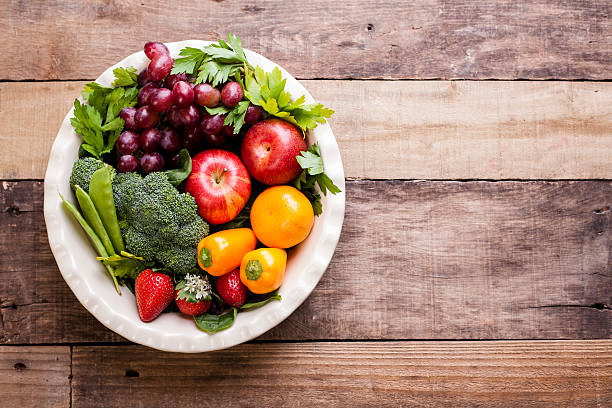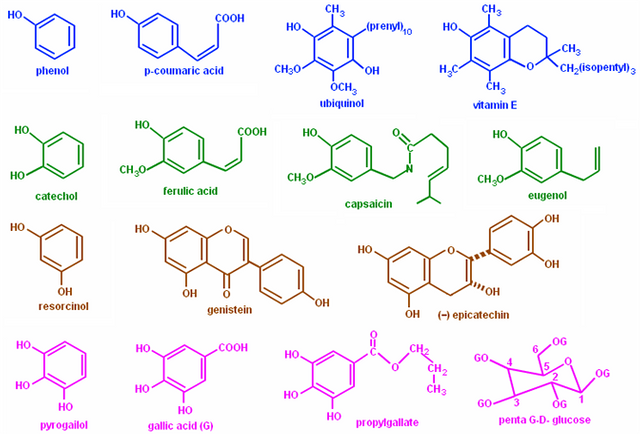The Miraculous Compounds of Nature - Phenolic Compounds
Phenolic compounds are important components because of the effects on the quality characteristics of foodstuffs which are important in terms of consumption such as appearance, taste and positive effects on human health as natural antioxidants.

Phenolic compounds are very important for fruit and vegetable products and products derived therefrom, since food affects flavor elements such as bitterness and astringency. Anthocyanins affecting the color of the fruit form a large group of phenolic compounds. The color that anthocyanis gives to fruits and products is important in terms of consumer preferences and quality characteristics. Anthocyanins are used as natural colorants in the food industry. In addition, some of the phenolic compounds are also used as natural sweeteners.
Due to the toxic and carcinogenic effects of synthetic antioxidants, interest in phenolic compounds which show natural antioxidant properties is increasing day by day in terms of health. Phenolic compounds as antioxidants are said to prevent many diseases such as cancer, heart diseases, cataracts, eye diseases, old age diseases etc. For this reason, consumption of fruit and vegetables with high phenolic content decreases the risk of getting diseases and positively affects health.

Phenolic compounds are divided into phenolic rings according to their structure and into different classes according to their bonding to each other. These are phenolic acids (hydroxybenzoic acid, hydroxycinnamic acid), flavonoids (flavonols, flavones, flavanols (catechins), flavanons, isoflavonoids, proanthocyanidins), stilbenes and lignans. Structural differences occur between phenolic acids, flavonoids, stilbenes and lignans.
Flavonoids
Flavonoids are molecules possessing the phenolic benzopyran structure. Among the phenolic compounds, flavon (2-phenyl-benzo-dihydro-pyran) derivatives are the most important group. They are structurally divided into six groups.
- Flavonols
- Flovonols
- Flavanones
- Flavanols
- Anthocyanidins
- Isoflavones
Flavonoids and other plant phenolics are commonly found in leaf, flower and stem parts of plants. They play an important role in the normal growth and maturation of plants as well as in their defense and protection against infections (harmful). It also allows plants to form and protect the colors of leaf, flower and fruit. It is stated that more than 4000 flavonoids are present in plants today. This figure continues to increase day by day.
Flavonols
Flavonols are the most common flavonoid species in food. The most common forms of flavonols are chemerol and quercetin. They are found in form of glycosides in foods. Quercetin is a very strong actioxidant. Flavones are not as common as flavonols. Light yellow colored compounds. The most common ones are luteolin and apigenin.
Flavanones
Flavanons are found in aromatic trees such as tomatoes and mint. But they are known to have higher concentrations in citrus. The most common ones are naringine, hesperidin and erythritis.
Isoflavones
Isoflavones are flavonoids commonly found in soybeans. In addition to this, some legumes also contain some. Soy and soy based products can be used as a basic isoflavone source for human nutrition.
Flavanols
Flavanols can exist in both monomer (catechin) and polymer (proantocyanidin) form. Catechins are found in almost every fruit. Catechin and epicatechin are the most common flavanols. Besides galloatechin, epigallocatechin and epigallocatechin are found in the seeds of some plants in flavanols such as galat.
Proanthocyanidins
Proanthocyanidins are compounds formed by the condensation of the flavan-3-ol structure of catechins chemically or enzymatically with dimers, oligomers and polymers. Condensation of catechin monomers usually takes place with C4 - C8 (sometimes C6) bonds. Proanthocyanidins are the main polyphenols found in grape juice.
Phenolic Acids
Phenolic acids are studied in two groups, benzoic acid and cinnamic acid derivatives. Hydroxybenzoic acids are compounds in a complex structure such as hydrolyzed tannins. Hydroxybenzoic acids are formed from hydroxycinnamic acids as a consequence of a reaction chain that is anologous to the β-oxidation of fatty acids.

Hydroxycinnamic acids are more common in foods than hydroxybenzoic acids. These are ferulic acid, p-coumaric acid, caffeic acid and sinapic acid. Since hydroxycinnamic acids are generally in the form of acid derivatives, they are not found in free form.
Lignans
Lignans are composed of two phenylpropane units. Flaxseed is known as the most abundant nutrient in lignans in terms of secoisolacericinol (3.7 g.kg-1) and, at a minimum, metaerethinol content. Other cereals, cereals, fruits and vegetables contain less lignans.
Stilbenes
It is a phenolic compound with very little place in human nutrition. The most common known stilbene is resveratrol. It has been discovered that anticarcinogenic effect when working with medical plants. It is stated that there are very few in red wine. However, it is suggested that quantities taken with normal foods are not possible to show any protective effect.
References
- Manach, C., Scalbert, A., Morand, C., Remesy, C. & Jimenez, L. (2004). Polyphenols: food sources and bioavailability. American Journal of Clinical Nutrition, 79, 727–747.
- Gharras El Hasna, (2009). Polyphenols: food sources, properties and applications-a review, İnternational Journal of Food Science and Tech., 44 , 2512-2518.
- https://en.wikipedia.org/wiki/Phenols
- http://chemistry.tutorvista.com/organic-chemistry/phenolic-compounds.html
img credz: pixabay.com
Nice, you got a 54.0% @peaceandlove upgoat, thanks to @kedi
It consists of $11.2 vote and $3.73 curation
Want a boost? Minnowbooster's got your back!
Very good post.